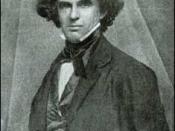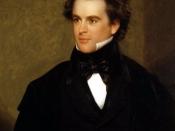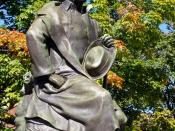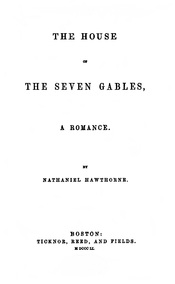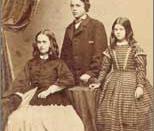Outline of Gothic Themes of The House of The Seven Gables Thesis Statement: Nathaniel Hawthorne's The House of The Seven Gables can be best appreciated for gothic themes of revenge, pride, and romance.
I. Life of Nathaniel Hawthorne A. Life B. Thesis Statement II. Revenge A. Between the Judge and Clifford B. Between Matthew Maule and Colonial Pyncheon III. Pride A. The pride of the Pyncheon family.
B. The pride of Hepzibah for her family name.
IV. Romance A. Between Phoebe Pyncheon and Clifford V. Conclusion A. Thesis Statement B. Review Nathaniel Hawthorne was born July 4, 1804, in Salem, Massachusetts. He was a descendent of early Puritan settlers, which had a great influence on his life and writings. When he graduated from Bowdoin College he published his first novel, anonymously, a gothic romance Fanshawe in 1828. The next ten years Hawthorne collected his stories and published them as Twice Told Tales in 1837.
In 1841 he moved into Brook Farm Community which was a transcendentalist group living. Hawthorne married Sophia Peabody in Boston July 9, 1842. After Mosses from an Old Manse in 1846 he couldn't support himself. In 1850 he published The Scarlet Letter and in 1851 The House of the Seven Gables and in 1852 The Blithedale Romance which made more then enough money for him and his wife and was the peak of his literary career. Nathaniel Hawthorne's The House of the Seven Gables can be best appreciated for gothic themes of revenge, pride, and romance.
Revenge is one of the gothic themes in The House of the Seven Gables. It is expressed between the Judge and Clifford in later years but starts with Matthew Maule's plan for revenge by cursing the Colonial Pyncheon and all further generations of the Pyncheons. "God", said the dying man, pointing his finger, with a ghostly look, at the undismayed continence of his enemy "God will give him blood to drink" (Hawthorne 3). The Colonial Pyncheon suddenly died in his home after shortly building it on Matthew Maule's land. And all further generations had some kind of tragic death or misfortune. "the sins of fathers are passed on to the children in succeeding generations" (Buckner 2737). Hepzibah Pynchoen lived in the house of the seven gables and was stricken with severe poverty and loneliness. All through her life she suffered through it.
Pride is another gothic theme in the novel. The Pyncheon name was always prestigious, they were looked upon with great admiration, that was until the curse. In one point of the novel Hepzibah Pyncheon is forced to open a small shop because of her poverty. The shop had not been open in years and she was afraid that it would put her family to shame. "Hepzibah's experience of opening the store makes a mockery of the Pyncheon family concept of pride" (Stubbs 89). Hepzibah knew of the pride of the family and it striked her with great concern. She finally decided it was either open the shop or starve. "the hereditary pride which had here been put to shame" (Hawthorne 24). This is what the old, dirty, abandoned shop meant to her. She opened it and cleaned it up but she was ashamed for she had demolished her family's sense of pride.
Romance is the last gothic theme. Young Phoebe Pyncheon falls in love and marries Clifford a descendent of the Maules. "How patiently did she endeavor to wrap Clifford up in her great, warm love, and make it all the world to him..." (Hawthorne 132). Clifford does not tell Phoebe the power he has over her for fear she may leave him. But, this romance was needed to end the curse of the Pyncheon's. "The burden of guilt is finally lifted when the young Phoebe Pyncheon falls in love with and marries the last descendant of the Maules, who refuses to exploit his power over her" (Soloman). So, the love of Clifford towards Phoebe ended the curse for the Pyncheon's who leave the house of the seven gables.
Nathaniel Hawthorne's The House of the Seven Gables can be best appreciated for gothic themes of revenge, pride, and romance. I think those who don't like reading a challenging book shouldn't try this one because it's not an easy book to keep up with, you must read it carefully. But if you like reading about a family's history and ancestors of the future generations and how the past effects the present, you should definitely read this book. I liked the romantic part of the book with Clifford and Phoebe. This is a good romance with other qualities to it including the gothic themes mentioned above.
WORK CITED Bucker, Sally. Master Plots. Ed. Frank N. Magill. Engle Cliffs, New Jersey, 1796.
Hawthorne, Nathaniel. The House of the Seven Gables. New York: Bantom Book, 1981.
Stubbs, John. "The House of the Seven Gables: Hawthorne's Comedy" Modern Critical Views Nathaniel Hawthorne. Ed. Harold Bloom. New Haven, CT: Chealsea House Publishers, 1986.
"Hawthorne, Nathaniel." Grolier Multimedia Encyclopedia. CD-Rom. 1999.
